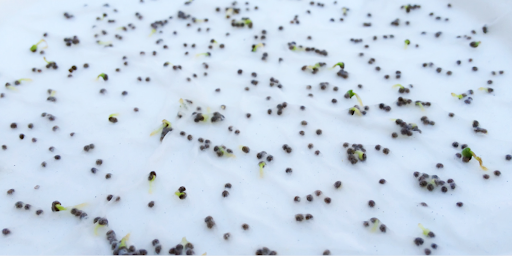
Seed germination is the cornerstone of agricultural success. It marks the beginning of a plant’s journey from a dormant seed to a thriving crop. Understanding the science behind germination can significantly impact the productivity of agricultural land. By creating optimal conditions for seeds to sprout, farmers and researchers can maximize yields, conserve resources, and contribute to sustainable farming practices. Tools like seed germination paper play a pivotal role in ensuring successful germination outcomes.
What Is Seed Germination?
Seed germination is the biological process through which a seed transforms into a young plant or seedling. This process occurs in three main stages:
1. Imbibition
During imbibition, the seed absorbs water, causing it to swell and break its outer shell. This is the first critical step in activating the seed’s metabolic processes.
2. Activation
Once hydrated, enzymes within the seed become active. These enzymes convert stored nutrients into energy, enabling growth.
3. Growth
The embryonic root (radicle) emerges first, anchoring the seedling into the soil. Subsequently, the shoot grows upward, signaling the start of photosynthesis.
Each stage of germination is influenced by environmental factors like temperature, moisture, oxygen, and light. Ensuring these conditions are ideal is essential for successful sprouting. Using seed germination paper can help provide these optimal conditions in a controlled manner.
Why Germination Matters in Agriculture
The germination stage directly impacts the growth, development, and eventual yield of crops. Successful germination leads to:
- Higher Crop Yields: Well-germinated seeds develop into healthy plants that produce abundant harvests.
- Efficient Land Use: Maximizing germination rates ensures that every inch of agricultural land contributes to productivity.
- Cost Savings: Healthy germination minimizes the need for re-sowing, saving farmers time and resources.
- Environmental Sustainability: Optimal germination reduces water, fertilizer, and pesticide usage, contributing to eco-friendly farming.
Specialized tools like seed germination paper ensure consistency and reliability in these critical early stages, especially in research and development.
Specialty-Grade Papers: A Game-Changer in Seed Germination
One of the key advancements aiding seed germination is the use of specialty-grade papers, such as seed germination paper. These papers are meticulously designed to provide ideal conditions for sprouting seeds, especially in research and development settings.
How Seed Germination Papers Work
- Controlled Environment: Seed germination paper retains moisture uniformly, ensuring consistent hydration for seeds.
- Air Permeability: It allows adequate oxygen flow, critical for metabolic activities.
- Sterility: Seed germination paper minimizes contamination risks, promoting healthy growth.
Seed germination paper is widely used by seed development companies and research institutions to test seed quality, study growth patterns, and refine agricultural practices. It provides reliable insights that pave the way for innovation in farming techniques.
Tips to Maximize Germination and Land Productivity
1. Use High-Quality Seeds
Start with seeds that are genetically strong and free from defects. Quality seeds have a higher likelihood of successful germination.
2. Prepare the Soil
Ensure the soil is nutrient-rich, well-drained, and free from pests. Proper soil preparation enhances seed-to-soil contact, fostering better germination.
3. Optimize Watering Practices
Seeds require consistent moisture for imbibition but can’t tolerate waterlogging. Monitor irrigation to strike the perfect balance.
4. Leverage Technology
Use tools like seed germination paper and temperature monitors to create controlled environments for sprouting. These tools help improve accuracy and reduce wastage.
5. Monitor Environmental Conditions
Pay attention to temperature, light, and oxygen levels. Adjusting these variables can significantly enhance germination rates.
Overcoming Challenges in Seed Germination
While germination is essential, it’s not without challenges. Common issues include:
- Poor Soil Quality: Address this by incorporating organic matter and fertilizers.
- Climate Variability: Use greenhouses or controlled environments to mitigate extreme weather effects.
- Pests and Diseases: Protect seeds with appropriate treatments and ensure hygienic handling.
Using tools like seed germination paper can also mitigate many of these challenges, offering a reliable solution for improving germination success.
Laxmi Industries: Pioneering Specialty-Grade Papers for Seed Germination
Laxmi Industries, established in 2004 in Hyderabad, India, has earned its reputation as a leader in manufacturing specialty-grade papers. Our seed germination papers are trusted by seed development companies and research institutions for their superior quality and performance.
Why Choose Laxmi Industries?
- Expertise: With two decades of experience, we understand the nuanced requirements of germination processes.
- Innovation: Our seed germination papers are designed to meet the evolving needs of agricultural research and development.
- Commitment to Quality: Every seed germination paper undergoes rigorous testing to ensure reliability and effectiveness.
Whether you are a farmer aiming to maximize your land’s potential or a researcher striving for precision, Laxmi Industries provides solutions that make a difference.
Conclusion
Understanding the science behind seed germination is essential for unlocking the full potential of agricultural land. By leveraging advanced tools like seed germination paper and adopting best practices, stakeholders in the agricultural sector can achieve remarkable results.
Laxmi Industries stands as a trusted partner in this journey, offering seed germination papers that empower farmers, researchers, and seed development companies to excel. Together, we can cultivate a future where agriculture thrives sustainably and productively.
